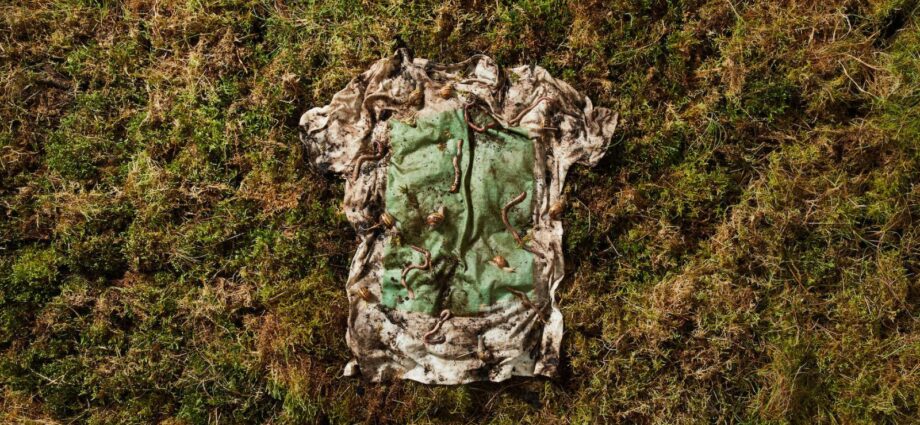As Fashion scrambles to reduce greenhouse emissions, Algae has been found to be a useful solution.
In the race to reduce and eventually eliminate the fashion industries usage of fossil fuels, Algae has been experimented to provide a renewable alternative.
Textile manufactures are usually exposed to toxic chemicals and heavy metals. It takes approximately 2,700 litres of freshwater to produce cotton for a T-shirt but using algae alternatives will reduce water usage by 80%
Algae only needs light, CO2 and water to grow at rapid speed!
The Algae formula can be used to create natural fibres and dyes producing zero waste or pollution. The organism is already being used in shoes and jackets replacing oil-based options and synthetic fabrics such as polyester.
Algae absorbs CO2 from the atmosphere, additionally helping the environment to reduce carbon.
How are Designers incorporating Algae
Charlotte McCurdy
Roughly 80% of current fabric is made using carbon.
Some designers have started experimenting with Algae and merging them in with other current fabrics. Critically, other designers like Charlotte find this way of using Algae, is using Algae for marketing and to appear sustainable. Rather than focusing on the bigger goal and abolishing the use of fossil fuels altogether.



Charlotte McCurdy has developed a process to produce a Bioplastic that can be used as material to create clothing. Like the raincoat (centre pic) She made 4 of these raincoats.
She uses Marine Macro Algae, a seaweed that she washes and submerges in water. It is then heated to separate a particular biological component of the Algae that she will use. The desired component is then moulded into flat sheets. Once it is cured it can then be cut to shape.
However, they are yet to make it to the market. She has found that the raincoats may be bio-degradable. This is great for the environment, but possibly not your wardrobe.
She has recently teamed up with designer Philip Lim. She uses the plastic she has invented to create sequins. As seen in the images above.
Vollebak
UK Brand Vollebak have been working closely with a bioscience company. There mission has been to find alternative solutions when dyeing fabric. Co-founder Steve Tinball acknowledges that the amount of carbon we use to produce a black colour is shocking. So finding new ways to create a black colour became a priority for vollebak.


They have found ways to use black algae as a dye for fabric. Black algae is a waste byproduct from algae. It had been previously used in food colouring and as a printing ink, but vollebak are the first company to use black algae as a fabric dye.
Although Vollebak are using algae as a fabric dye, they make sure their clothing stays natural. Their T-shirts are made from a combination of cotton and ‘SeaCell’ (a blend of pulped eucalyptus and seaweed).
Pangaia
All-natural clothing brand Pangaia are excited about their usage of seaweed. They acknowledge its abundance and plan to make 100% seaweed fibre products. They for now blend it with cotton fabrics

Pangaia have been using a lot more then seaweed and algae. Read more about Pangaia’s innovative collection here.
DS AUTOMOBILE
Over in France DS Automobiles have released a piece collection using algae. The Algae coats the fabric and draws out CO2 from the air and turns it into oxygen. This is also a milestone in carbon capture for the industry. As not only does it capture, but it gives back.

READ RELATED ARTICLE ABOUT DS AUTOMOBILES AND CARBON CAPTURE HERE
The Future Development of Algae
Algaeing is an organisation that aims to develop new sustainable solutions from algae. Their aim is to redesign the fashion industry for the future generations
Clothing made from algae are likely to be photosynthetic and absorb Co2 from the air whilst releasing oxygen just like plants. Unlike cotton, algae don’t take up mass field space to grow. It grows rapidly and uses a lot less water.
But it doesn’t come without its tweaks. Algae clothing cannot be hung in dark places like a wardrobe, it will need sunlight and like discussed in our article on Carbon Capture, algae will need misting with water, just like a plant.
Unfortunately, It’s not quite ready to used on its own, it will still need to be blended with other materials. On it’s own, it is not a tough material, making it difficult to withstand the elements for a long time. However, Delft university and the university of Rochester have been researching ways to make algae-based products that are more durable. Being a abundant component, alongside its carbon capturing elements, Algae is looking promising for the future of fashion.
The fashion industry is changing. It has too. It is at a point where it has no choice. However, it is for the greater good and it’s time the fashion industry acknowledges its role towards the environment. In the future we will be wearing nature!

